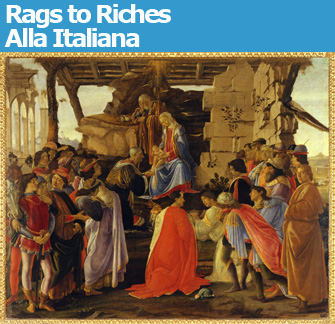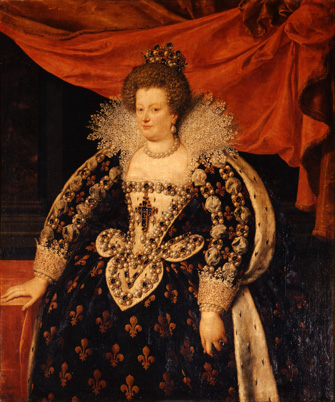 |
|
“Adoration of the Magi” (1476) by Sandro Botticelli. |
You might call it an Italian rags-to-riches story: a family of wool traders-turned-bankers who grew so fabulously wealthy that they were able not only to wrest political control of …
 |
|
“Adoration of the Magi” (1476) by Sandro Botticelli.
|
You might call it an Italian rags-to-riches story: a family of wool traders-turned-bankers who grew so fabulously wealthy that they were able not only to wrest political control of the “republic” that was Florence during the Renaissance but also to become some of the world’s greatest patrons of the arts. As the generations came and went, scions of the house of Medici became cardinals and popes, and – to the dismay of the French people and of royalists everywhere – two members of this house founded by merchants, Catherine and Marie, became queens of France.
Normally a trip to Florence is required to see the fabulous works of art collected by the Medici, but now a sample of the family treasure – including paintings, drawings, sculptures, furniture and objects – is on show in “Trésor des Médicis” at the Musée Maillol in Paris.
The exhibition seeks to plunge visitors into the Medici lifestyle. The first room is the highlight: the floor is decorated with a Florentine-style pattern, and the mirrored walls and columns seem to enlarge the room, creating the illusion that you are in a grand palace and reflecting a massive bronze sculpture of a horse’s head here or an Etruscan statue there. Most of the show’s star pieces can be found in this room.
An austere little Fra Angelico does not seem to be one of the friar-painter’s best works, although the composition and colors are lovely, but Sandro Botticelli’s magnificent “Adoration of the Magi” (1475-76) is a joy, and not just because most of the figures are portraits of members of the Medici family (and perhaps of Botticelli himself, on the far right). Each of the faces in the crowd surrounding the Holy Family is individualized and alive with expression. Many of the figures in the crowd look out of the canvas right into your eye, even the horse on the far left. Note the arrogant stance of the young man next to the horse, the peacock watching the proceedings from on high on the right, the details of gold and lace on the rich clothing, the sumptuous red cloak of the central kneeling figure (the big splash of red-orange steals the thunder from the Holy Family above him) and the hat sitting on the ground next to him.
The Medici not only patronized great artists and architects – among them Masaccio, Brunelleschi, Donatello, Fra Angelico, Michelangelo, Leonardo da Vinci, Raphael and Vasari – but also collected works from Antiquity. On show here, along with several delicate Roman cameos, is a marvelous first-century-B.C.E. Etruscan bronze statue of an orator, found in a vineyard and brought to Cosimo I by Vasari. Look at the way the shape of his foot can be discerned through his footwear.
Other notable pieces both on the ground floor and upstairs are a stunning portrait of a young man by Bernardo and Neri de’ Nerli in an illuminated edition of the works of Homer; the lovely portrait of Eleanor of Toledo (1543) by Agnolo Bronzino ; and Raphael’s portrait of Tommaso Inghirami, (c. 1510), in which Pope Leo X’s librarian, a symphony in red with just the slightest hint of a five-o’clock shadow on his face, casts his eyes up toward heaven, while one of his hands, with their delicate, chubby fingers, holds a pen and the other rests on the page of a book.
The portrait of Marie de’ Medici painted in all her bejeweled splendor in 1611 as regent of France by Frans Pourbus the Younger makes a nice contrast with Anthony Van Dyck’s 1632 portrait of the exiled Marie, all in black with her
|
|
|
“Portrait de Marie de Médicis” (1611) by Frans Pourbus. Photo: Archivio Fotografico della Soprintendenza per il Polo Museale Fiorentino tino |
crown at her side rather than on her head, currently on show in “Rubens, Poussin et les Peintres du XVIIe Siècle”
As you continue to wend your way toward the end of the show, the decline of the house of Medici becomes evident in the changing artistic tastes, especially the religious kitsch commissioned or collected by later generations, most notably a lavish bas-relief ex-voto showing a kneeling Cosimo II, finely executed in precious stones, enamel, diamonds and gilt bronze. There are still many highlights, however, among them two marvelous marble-topped tables inset with a colorful profusion of flowers, fruits, plants, birds and insects in precious stones; and a few beautiful drawings, collected by Cardinal Leopoldo, by Primaticcio, Titian and Simon Vouet.
The house of Medici expired in 1743, with the death of Anna Maria Luisa de’ Medici, Dowager Electress Palatine, who willed the Medici treasure to the state of Tuscany, with the stipulation that it be kept in Florence. Luckily, a few pieces have made a temporary escape to Paris for this show.
Musée Maillol: 61, rue de Grenelle, 75007 Paris. Métro: Rue de Bac. Tel.: 01 42 22 59 58. Open Wednesday-Monday, 10:30am-7pm (until 9:30pm on Friday). Admission: €11. Through January 31, 2010. www.museemaillol.com
Order books on the house of Medici from Paris Update’s Amazon store at no extra cost. Click on your preferred Amazon location: U.K., France, U.S.
Support Paris Update by ordering books from Paris Update’s Amazon store at no extra cost. Click on your preferred Amazon location: U.K., France, U.S.
Reader Reaction: Click here to respond to this article (your response may be published on this page and is subject to editing).
More reviews of Paris art shows.
© 2010 Paris Update
Favorite
